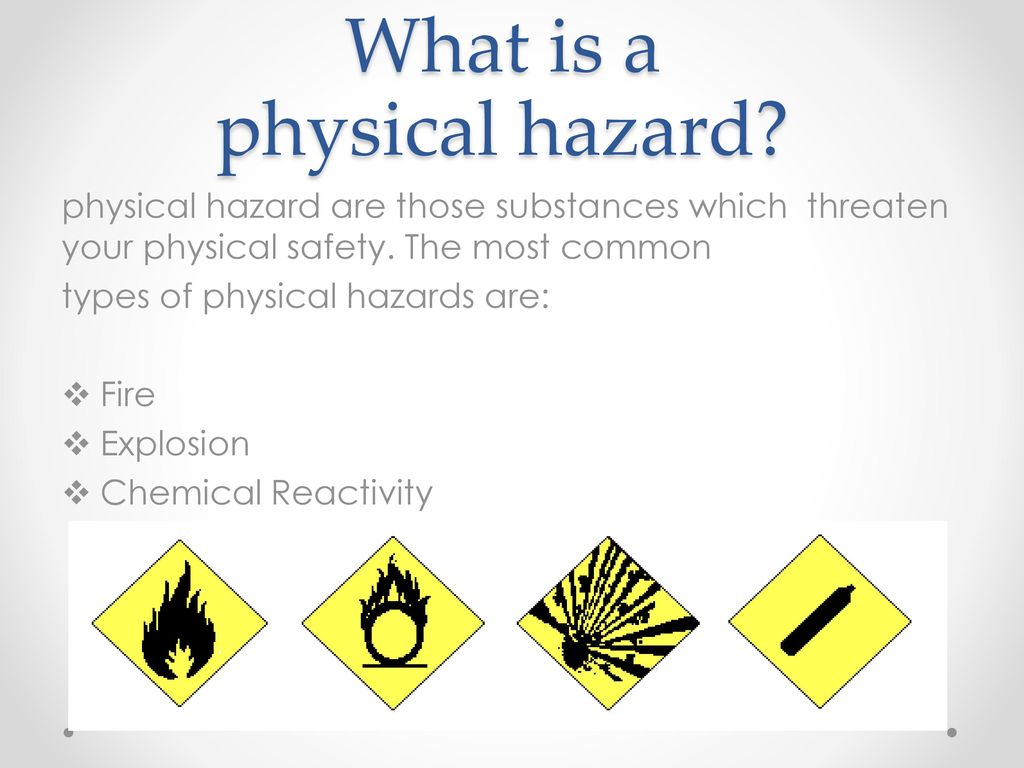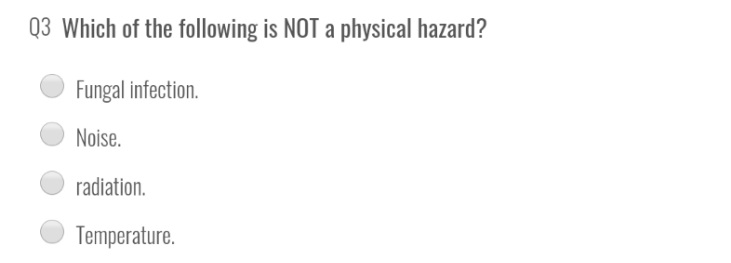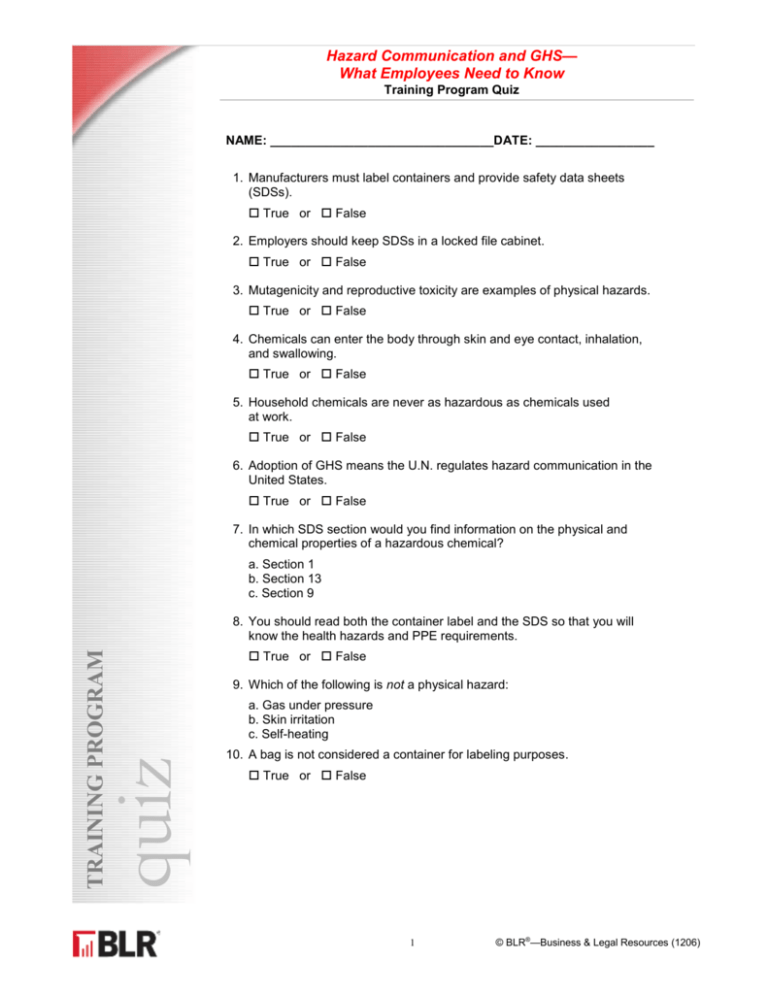Which of the Following Is Not a Physical Hazard
It must be worn correctly. Below are the basic steps in auditing your chemical products to properly classify them under GHS standards.
Pyrophoric liquids or solids Self-Heating Substances.

. There are 4 hazards associated with working in a confined space. Physical Hazards Physical hazards that employees in the workplace face include excessive levels of ionizing and nonionizing electromagnetic radiation noise vibration illumination and temperature. Including ionizing non-radiowaves etc breathing problems.
It is the process of thickening and intensifying the flavor of a liquid mixture such as a soupsauce wine or juice by simmering or boilingA. 3AB Many chemicals are both physical and health hazards. Determine if the chemical is hazardous based on its physical hazards health hazards and environmental hazards.
1 pts Question 6 Tennis elbow. These are health hazards posed by a hazardous chemical. A Physical b Health c Hazards Not Otherwise Classified HNOC d Environmental non-mandatory 5.
Hand arm vibration syndromes. A bag is not considered a container for labeling purposes. A Flammable Liquids b Organic Peroxides c Flammable Aerosols d Flammable Aerosols.
Identify the relevant data concerning the hazards of the chemical. Specific target organ toxicity repeated exposure. The Simple Step by Step Process to Classifying a Hazard.
It is considered as a simple technique in sauce preparationA. NYC Food Protective Course. Below are the list of confined space hazards which is associated with the above type of hazards.
Noise 5 more terms. Which of the following is NOT a physical hazard in the home. In order to be effective the right PPE for the job must be used and.
Which of the following is not a physical hazard. NYC Food Protective Course. SDSs must always be accessible to the employees.
Time And Temperature Cold Running Water Physical Hazard New York City Food Preparation. This label warns you of a physical hazard flamiability by telling you not to use the chemical near fue or flame It warns you of a health hazard by telling you that the chemical is harmfid when it enters your body ie when swallowed inhaled or absorbed through the skin. Respiratory or skin sensitization.
These foreign objects include but are not limited to bone or bone chips metal flakes or fragments injection needles BBs or shotgun pellets pieces of product packaging stones glass or wood fragments insects or other filth. Toxicity - Many of the commonly used cryogenic gases are considered to be of low toxicity but still pose a hazard from asphyxiation. It must be brand new.
For example exposed wires or a damaged carpet might result in a tripping hazard. Biological chemical physical and allergenic. Inadequate lighting in and out of the house Situation 6.
Combustible or not a fin. These hazards are most common in different industries especially in mining and construction industries. Specific target organ toxicity single exposure.
Gas under pressure b. Large windows that allow good ventilation C. These are hazards that create unsafe working conditions.
Criteria for classifying chemicals have been developed for the following physical hazard classes. Each have their own unique characteristics but all can be avoided through a robust food safety management system FSMS. Flammable gases liquids solids and aerosols Oxidizing gases liquids or solids Self-Reactive Substances.
Eileen 45 years old is admitted to the hospital with a diagnosis of renal calculi. A physical hazard is defined as A factor within the environment that can harm the body without necessarily touching it Vibration and noise are examples of physical hazards. Asphyxiation and chemical toxicity are hazards encountered when entering an area that has been used to store cryogenic liquids if proper ventilationpurging techniques are not employed.
It must be color coordinated. All of the above are true. Germ cell mutagenicity.
For example a poor. These are sometimes included under the category of physical hazards. Serious eye damageeye irritation.
High exposure to sunlightultraviolet rays Temperature extremes hot and cold Constant loud noise ERGONOMIC HAZARDS. A The most commonly thought of hazard in construction. Which of the following is NOT a physical hazard.
Which of the following is NOT a GHS physical hazard. Which of the following is not a physical hazard discussed in the safety lecture presentation. There are four primary categories of food safety hazards to consider.
Chemical Flash Point Answer Turpentine 95F Flammable I Kerosene 100-165F B Combustible Auto lubricating Oil 300-450F C Not a fire hazard Toluene 40F Flammable Methyl cellosolve 115F B Combustible Ethylene glycol 232F C Not a fue hazard. Self-heating substances and mixtures. It must belong to the lab it is used in.
Hazards in Confined Space and Control Measures. This hazard includes radiation extreme temperatures noise and vibration. There are different physical hazard types.
A Physical Hazard is classified as posing one of the following hazardous effects. A physical hazard is a circumstance factor or agent that may harm after making contact. Reinforce definitions with answers.
Physical hazards not otherwise classified. All of the following are GHS hazard categories EXCEPT. Understanding the risks associated with each can dramatically reduce the potential of a foodborne illness.
Unstable and slippery stairway B. In occupations where there is exposure to ionizing radiation time distance and shielding are important tools in ensuring worker safety. Ergonomic hazards are a result of physical factors that can result in musculoskeletal injuries.
Obstacle people cam trip over like door mats rugs electric cords D. These hazards are unavoidable in some specific industries like the construction industry. True or False 1.
Lack of oxygen can happen when air feed is not. A physical hazard is any extraneous object or foreign matter in a food item which may cause illness or injury to a person consuming the product. Self-reactive substances and mixtures.
Are factors within the environment that can harm the body without necessarily touching it.

Physical Hazard Associated With Chemicals Ppt Download

Connectosh Physical Hazard Are Based On The Intrinsic Facebook

Solved Q3 Which Of The Following Is Not A Physical Hazard Chegg Com

No comments for "Which of the Following Is Not a Physical Hazard"
Post a Comment